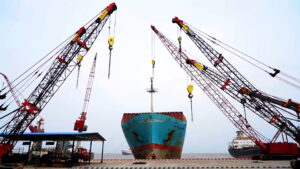- Leading ship recycling company and has been established in 1983
Key Components of Shipbreaking Environmental Regulations
Shipbreaking has been touted as a way of managing large, abandoned shipwrecks, responsible for causing marine pollution. However, ironically shipbreaking itself leaves a lot of toxins in the sea, proving to be a primary threat to wildlife and humanity. Ship recycling is a labor-intensive process and employs thousands of laborers who work in hazardous conditions to carry out the dismantling process. Therefore there is a need for a regulatory body and a set of guidelines to monitor ship breaking and ensure the safe and environmentally responsible dismantling and recycling of ships.
R.L. Kalthia has brought this blog to dig deeper into environmental regulations surrounding shipbreaking and elaborate on the Key Components of Shipbreaking Environmental Regulations. The regulations strive to mitigate the potential negative impacts of shipbreaking activities on the environment, human health, and worker safety. There are different components of shipbreaking environmental regulations that look after various aspects related to ship dismantling. Let’s investigate further into the shipbreaking environmental regulations and discuss its different components.

Regulatory Bodies to Ensure Shipbreaking Environmental Compliance
There are various regulatory bodies working to develop and enforce shipbreaking environmental regulations. These regulatory bodies work at national, regional, and international levels. Some of the prominent regulatory bodies are mentioned below:
International Maritime Organization (IMO): IMO is a specialized agency of the United Nations that play a significant role n framing regulations for environmental protection. It has developed conventions such as the Hong Kong International Convention for the Safe and Environmentally Sound Recycling of Ships, which provides guidelines for safe and environmentally responsible ship recycling.
Basel Convention: The Basel Convention is an international treaty that addresses the management and transboundary movement of hazardous wastes, also, those generated from shipbreaking activities. It also frames guidelines on the transport and disposal of hazardous waste to minimize its harmful effects on human health and the environment.
National Regulatory Authorities: All the prominent countries involved in shipbreaking have their separate governing bodies responsible for monitoring shipbreaking activities and enforcing environmental regulations. These national authorities comprise maritime administrations, environmental protection agencies, labor departments, and other relevant government bodies.
Classification Societies: Classification societies are private organizations that examine and accredit abandoned ships’ compliance with several technical and safety standards. They play an important role in ensuring adherence to international regulations and industry-friendly practices during the shipbuilding, operation, and recycling stages.
Regional Organizations: Regional agreements and organizations significantly contribute to framing shipbreaking governmental organizations. Many European countries have implemented ship recycling regulations that set guidelines for safe and environmentally sound shipbreaking in all European states.
Key Components of Shipbreaking Environmental Regulations
With the potential risk for human health, wildlife, and marine life, shipbreaking various regulations have been established to ensure safe and environmentally responsible ship recycling activities. The shipbreaking environmental regulations minimize the environmental risks posed by ship recycling. Go through the Key Components of Shipbreaking Environmental Regulations to get a better idea:
Hazardous Materials Management: Ship recycling generates a lot of radioactive and toxic waste such as asbestos, PCBs, heavy metals, and fuels. Environmental regulations ensure that all hazardous waste is identified, handled, and disposed of to prevent environmental contamination and protect human health.
Waste Management: Shipbreaking results in a lot of solid, liquid, and oily wastewater that can significantly harm marine life and workers deployed at the shipbreaking yard. The stringent rules and regulations allow you to manage the waste using segregation, treatment, recycling, and safe disposal methods.
Environmental Impact Assessment (EIA): Before the commencement of ship recycling all the shipbreaking facilities are required to conduct an Environmental Impact Assessment (EIA). This evaluation assesses the potential environmental risks and impacts related to shipbreaking activities, such as pollution, habitat destruction, and ecosystem disturbance.
Worker Health and Safety: These regulations ensure the safety and health of workers, working in the shipbreaking yard. This includes providing optimum training, and personal protective equipment (PPE), and ensuring compliance with occupational safety standards.
Ship Recycling Facilities: Regulations have made it mandatory for shipbreaking yards and facilities to acquire certain licenses and certifications. These accreditations include infrastructure requirements, environmental management systems, worker facilities, and relevant laws and regulations.
Compliance and Enforcement: Regulatory authorities implement ship recycling regulations using inspections, audits, and monitoring of shipbreaking activities. Any deviation from the regulations can lead to penalties, fines, or suspension of operations, ensuring adherence to environmental regulations.
Conclusion
The need for Shipbreaking Environmental Regulations is non-negotiable in ensuring the safety and health of workers, and also in keeping the environment safe. However, it is noteworthy that these regulations are not similar in all the countries engaged in large-scale ship recycling. The regulation also depends on the specific legal frameworks and priorities of each jurisdiction. International regulatory authorities such as International conventions and agreements, developed by the International Maritime Organization (IMO), immensely contribute to setting global standards for shipbreaking practices. You can contact R.L. Kalthia to get more informative insights on ship recycling and can enquire about our other services. To know more drop an email at info@kalthiashipbreaking.com